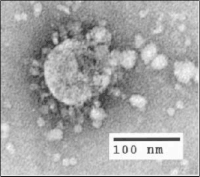
Photo from wikipedia
The rapid emergence of SARS-CoV-2 has created a global health emergency. While most human SARS-CoV-2 disease is mild, some people develop severe, life-threatening disease. ABSTRACT The rapid emergence of severe… Click to show full abstract
The rapid emergence of SARS-CoV-2 has created a global health emergency. While most human SARS-CoV-2 disease is mild, some people develop severe, life-threatening disease. ABSTRACT The rapid emergence of severe acute respiratory syndrome coronavirus 2 (SARS-CoV-2) has created a global health emergency. While most human disease is mild to moderate, some infections lead to a severe disease characterized by acute respiratory distress, hypoxia, anosmia, ageusia, and, in some instances, neurological involvement. Small-animal models reproducing severe disease, including neurological sequela, are needed to characterize the pathophysiological mechanism(s) of disease and to identify medical countermeasures. Transgenic mice expressing the human angiotensin-converting enzyme 2 (hACE2) viral receptor under the control of the K18 promoter develop severe and lethal respiratory disease subsequent to SARS-CoV-2 intranasal challenge when high viral doses are used. Here, we report on SARS-CoV-2 infection of hamsters engineered to express the hACE2 receptor under the control of the K18 promoter. K18-hACE2 hamsters infected with a relatively low dose of 100 or 1,000 PFU of SARS-CoV-2 developed a severe and lethal disease, with most animals succumbing by day 5 postinfection. Hamsters developed severe lesions and inflammation within the upper and lower respiratory system, including infection of the nasal cavities causing marked destruction of the olfactory epithelium as well as severe bronchopneumonia that extended deep into the alveoli. Additionally, SARS-CoV-2 infection spread to the central nervous system (CNS), including the brain stem and spinal cord. Wild-type (WT) hamsters naturally support SARS-CoV-2 infection, with the primary lesions present in the respiratory tract and nasal cavity. Overall, infection in the K18-hACE2 hamsters is more extensive than that in WT hamsters, with more CNS involvement and a lethal outcome. These findings demonstrate the K18-hACE2 hamster model will be valuable for studying SARS-CoV-2. IMPORTANCE The rapid emergence of SARS-CoV-2 has created a global health emergency. While most human SARS-CoV-2 disease is mild, some people develop severe, life-threatening disease. Small-animal models mimicking the severe aspects of human disease are needed to more clearly understand the pathophysiological processes driving this progression. Here, we studied SARS-CoV-2 infection in hamsters engineered to express the human angiotensin-converting enzyme 2 viral receptor under the control of the K18 promoter. SARS-CoV-2 produces a severe and lethal infection in transgenic hamsters that mirrors the most severe aspects of COVID-19 in humans, including respiratory and neurological injury. In contrast to other animal systems, hamsters manifest disease with levels of input virus more consistent with natural human infection. This system will be useful for the study of SARS-CoV-2 disease and the development of drugs targeting this virus.
Journal Title: mBio
Year Published: 2022
Link to full text (if available)
Share on Social Media: Sign Up to like & get
recommendations!